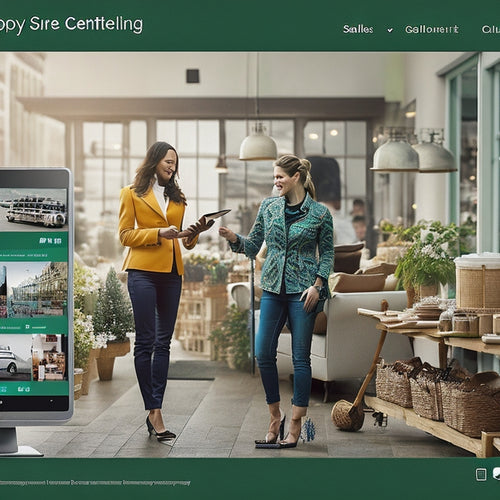
Creating a Profitable Online Course Implementation Plan
Share
You're close to launching your online course, but without a solid implementation plan, you risk falling short of your goals. To create a profitable online course, start by defining clear objectives and identifying your target audience. Then, choose a relevant course platform and develop engaging content that resonates with your learners. Set realistic pricing strategies, build credibility and trust, and design a user-friendly interface. Don't forget to establish support systems to guarantee student success. By following these steps, you'll be well on your way to creating a profitable online course. Now, take the next step to turn your vision into a thriving online business.
Key Takeaways
• Define clear and measurable course objectives using SMART criteria to ensure effective learning outcomes and track progress.
• Analyze the target audience's pain points, motivations, and customer journey to tailor course content and maximize conversions.
• Choose a user-friendly learning management system and video conferencing tools to provide mobile compatibility, technical support, and data security.
• Set competitive pricing based on market research and value-based models, offering tiered pricing options, discounts, and flexible payment plans.
• Gather feedback through surveys, evaluations, and data analysis to update content, build credibility, and establish comprehensive support systems.
Defining Online Course Objectives
To guarantee your online course achieves its intended outcomes, define clear and measurable goals that outline what learners will be able to do or demonstrate upon completing the course. This involves evaluating learning outcomes, which should be specific, measurable, achievable, relevant, and time-bound (SMART).
By setting SMART goals, you'll be able to evaluate learner progress and determine whether your course is meeting its intended goals. Effective goal setting strategies involve breaking down broad goals into smaller, manageable chunks, and establishing key performance indicators (KPIs) to track learner progress.
When setting goals, consider what learners will be able to do, know, or demonstrate upon completing the course. For instance, will they be able to apply new skills, solve complex problems, or articulate key concepts?
Identifying Target Audiences
Now that you've defined your online course objectives, it's time to identify your target audiences. To do this, you'll need to create ideal learner profiles, analyzing their pain points and motivations to understand what drives them.
Ideal Learner Profiles
You'll want to identify your ideal learner profiles by analyzing the demographics, needs, and preferences of your target audience. This involves creating learner personas, which are semi-fictional representations of your ideal learners. By understanding their goals, challenges, and behaviors, you can develop targeted engagement strategies that resonate with them.
To create accurate learner personas, map out the customer journey, from awareness to purchase. Identify the touchpoints where learners interact with your brand, and gather feedback through surveys, focus groups, or one-on-one interviews. This will help you understand their pain points, motivations, and expectations.
Use this information to develop buyer personas that outline their demographics, goals, challenges, and preferred communication channels.
Pain Points Analysis
Identifying your target audience's pain points is vital in creating an online course that addresses their specific needs and concerns. You need to understand what keeps them up at night, what they struggle with, and what they're eager to achieve. This is where pain points analysis comes in.
By conducting surveys, interviews, or focus groups, you can gather valuable insights into your audience's pain points. This will help you create an online course that resonates with them, increasing learner engagement and ultimately, driving business results.
Analyzing student feedback is also important in identifying areas for course improvement. You can use this feedback to refine your course content, making it more relevant and effective. For instance, if students are facing challenges with a particular concept, you can create additional resources or modify your teaching approach to better support them.
Demographic Segmentation
To create an online course that resonates with your ideal learners, segmenting your target audience based on demographics, such as age, occupation, education level, and geographic location, is essential. This process, known as demographic segmentation, allows you to identify specific groups within your larger audience and tailor your course content to meet their unique needs.
Conducting market research is vital to gathering data on your target audience. You can use online tools, surveys, and focus groups to collect information on their demographics, interests, and pain points. This data will help you create customer segmentation profiles, which outline the characteristics, needs, and behaviors of each group.
By analyzing these profiles, you can develop targeted marketing strategies that speak directly to each segment. Behavior analysis is also critical in understanding your target markets. By examining how each segment interacts with your course content, you can identify patterns and preferences that inform your marketing and sales strategies.
Choosing Relevant Course Platforms
When developing an online course, selecting a suitable platform is essential, as it directly impacts the learning experience and your ability to effectively deliver course content. You'll want to assess platforms that offer flexibility in course customization, allowing you to tailor the learning environment to your specific needs.
To make an informed decision, you should conduct a thorough platform comparison, weighing the pros and cons of each option. Here are three key factors to contemplate:
-
Customization options: Can you personalize the platform to fit your brand and course needs?
-
User experience: How easy is it for learners to navigate the platform and access course materials?
-
Technical support: What kind of assistance does the platform offer in case you encounter technical issues?
Developing Engaging Course Content
Now that you've chosen a suitable course platform, it's time to focus on creating engaging content that resonates with your learners.
To do this, you'll need to define clear learning objectives, craft compelling lesson plans that meet those objectives, and design interactive activities that keep students motivated and involved.
Define Learning Objectives
You'll need to establish precise learning goals for your online course, as they serve as a roadmap for creating focused and engaging content that meets your students' needs. By defining what you want your students to learn, you'll be able to design a course that effectively achieves those goals. This is where instructional design comes in – it's the process of planning and creating learning experiences that meet specific goals.
To create effective learning goals, consider the following:
-
Specificity: Make sure your goals are clear and concise, avoiding vague statements that can be open to interpretation.
-
Measurability: Guarantee your goals can be measured through assessment strategies, allowing you to track student progress and understanding.
-
Relevance: Align your goals with the needs and interests of your target audience, ensuring the course content remains engaging and relevant throughout.
Craft Compelling Lesson Plans
With your learning objectives clearly defined, you can start crafting lesson plans that transform these objectives into engaging, interactive, and informative learning experiences for your students. A well-structured lesson plan is essential to achieving this goal.
Start by creating a clear and concise lesson structure that outlines the learning outcomes, topics to be covered, and the time allocated to each activity.
To keep your students engaged, incorporate various engagement techniques, such as storytelling, real-life examples, and multimedia content. This will help to break the monotony of traditional teaching methods and make your course more appealing.
When it comes to content delivery, consider using a mix of text, images, and videos to cater to different learning styles. Assessment methods should also be varied, including quizzes, assignments, and discussions, to evaluate students' understanding and progress.
Design Interactive Activities
To create an immersive learning experience, design interactive activities that challenge your students to apply their knowledge, think critically, and solve real-world problems. By doing so, you'll not only increase student engagement but also enhance interactivity, ultimately leading to a more effective learning process.
Here are three ways to design interactive activities that drive results:
-
Scenario-based simulations: Create realistic scenarios that mimic real-world challenges, allowing students to apply theoretical knowledge in practical ways.
-
Group discussions and debates: Encourage students to engage in meaningful discussions and debates, promoting critical thinking, problem-solving, and effective communication.
-
Interactive quizzes and games: Develop quizzes and games that assess students' understanding of key concepts, providing instant feedback and opportunities for improvement.
When designing interactive activities, it's crucial to assess engagement and adjust your approach accordingly. By regularly evaluating student participation and feedback, you can refine your strategy to guarantee maximum engagement and learning outcomes.
Setting Realistic Pricing Strategies
Setting Realistic Pricing Strategies
By researching your competition and understanding the value your online course provides, you can set a realistic price that attracts students while ensuring your business stays profitable. Conduct a competitive analysis to identify gaps in the market and determine how your course stands out from the rest. This will help you position your course effectively and set a price that reflects its unique value proposition.
When determining your pricing strategy, consider the costs associated with creating and delivering your course, as well as the costs of marketing and promoting it. You should also consider the price sensitivity of your target audience and the level of competition in your market. Finding a balance between attracting students and maintaining profitability is crucial.
Creating Effective Sales Funnels
You'll need a well-designed sales funnel to guide potential students through the buying process and maximize conversions for your online course. A sales funnel is a series of steps that potential students take to become paying customers. It's essential to create an effective sales funnel that resonates with your target audience and addresses their pain points.
Here's a breakdown of a successful sales funnel:
-
Awareness: Use social media advertising to grab the attention of potential students and drive traffic to your landing page.
-
Interest: Nurture leads through email marketing campaigns that provide valuable content and insights, building trust and credibility.
-
Conversion: Offer a free trial or demo to give potential students a taste of your online course, making it easier for them to convert into paying customers.
Building Credibility and Trust
By crafting a sales funnel that addresses the needs and pain points of your target audience, you've already taken the first step in building credibility and trust with potential students.
Now, it's time to amplify that effort by implementing trust-building strategies that showcase your expertise and credibility indicators. One effective way to do this is by featuring testimonials from satisfied students who've achieved real results from your course. These social proof elements can be showcased on your website, social media, or email marketing campaigns.
Case studies that highlight the challenges, solutions, and outcomes of your course can also be powerful credibility indicators. By sharing these success stories, you're demonstrating your ability to deliver on your promises and establishing yourself as an authority in your niche.
Designing User-Friendly Interfaces
To guarantee a seamless learning experience, your online course's interface must be thoughtfully designed to guide students through complex topics with minimal cognitive load. This means creating an intuitive and visually appealing environment that fosters user engagement and encourages active learning.
Here are three key considerations to keep in mind when designing your online course's interface:
-
Clear Navigation: Assure that students can easily navigate through your course content, with clear and concise labels and minimal clutter.
-
Consistent Visual Design: Establish a consistent visual design language throughout your course, using a limited color palette, typography, and imagery to create a cohesive and professional look.
-
Interactive Elements: Incorporate interactive elements, such as quizzes, discussions, and gamification, to break up text-heavy content and encourage active participation.
Establishing Support Systems
Design a thorough support system that provides students with multiple channels to seek help, clarifies expectations, and fosters a sense of community. This will enable you to build a loyal student base and increase the chances of success for your online course.
To achieve this, you'll need to provide resources that cater to different learning styles and preferences. Here's a breakdown of what you can offer:
| Support Channel | Description |
|---|---|
| Email Support | Dedicated email address for students to send queries and concerns |
| Discussion Forum | Online platform for students to interact, ask questions, and share experiences |
| Live Office Hours | Regular live sessions where students can ask questions and get instant feedback |
| Video Tutorials | Supplemental video content that provides step-by-step guidance on complex topics |
Measuring and Optimizing Performance
As you move forward with your online course, you'll want to keep a close eye on its performance.
To do this, you'll need to track key metrics that reveal how students are progressing and where they might be struggling.
Track Key Metrics
Measuring the right metrics is essential to understanding how your online course is performing and identifying areas for improvement, so you can refine your strategy and boost learner engagement. To get a clear picture of your course's performance, you need to track key metrics that matter.
This is where data analytics comes in - it helps you collect and analyze data to inform your decisions.
Here are three key metrics to track:
-
Completion Rate: The percentage of learners who complete your course. This metric helps you identify areas where learners might be struggling or losing interest.
-
Engagement Metrics: Such as time spent on the platform, clicks, and interactions. These metrics help you understand how learners are interacting with your course content.
-
Net Promoter Score (NPS): A measure of learner satisfaction and loyalty. This metric helps you identify areas for improvement and refine your course to meet learner needs.
Analyze Student Progress
You'll want to regularly analyze student progress to identify areas where learners are excelling or struggling, and then use that data to optimize your course's performance. This involves progress monitoring, which helps you track learners' advancement through the course and identify knowledge gaps.
By using effective assessment strategies, you can gather valuable insights into student performance and adjust your teaching methods accordingly.
To take it a step further, you should also focus on student engagement and retention tactics. This includes monitoring course completion rates, student participation, and overall satisfaction. By analyzing these metrics, you can identify areas where learners may be disengaging and implement targeted interventions to re-engage them.
For instance, you might introduce interactive elements, such as gamification or discussion forums, to increase student participation and motivation.
Frequently Asked Questions
Can I Sell My Course on Multiple Platforms Simultaneously?
You can sell your course on multiple platforms simultaneously, but be aware that platform exclusivity agreements may restrict this. Develop marketing strategies that adapt to each platform's unique audience and algorithms to maximize visibility and sales.
How Do I Handle Refunds and Course Dissatisfaction?
You'll want to establish a clear refund policy, ensuring transparency and managing customer expectations. When handling complaints, prioritize empathy and prompt resolution, providing excellent customer service to maintain a positive reputation.
What's the Ideal Course Length for Maximum Engagement?
You'll find the sweet spot for maximum engagement by considering your course objectives and ideal duration, balancing thorough content with concise lessons to keep students hooked, and incorporating clever engagement strategies to boost student retention.
Can I Use Copyrighted Materials in My Course Content?
"Ah, you think you're a rebel, don't you? Using copyrighted materials without permission? Newsflash: you're not above the law. Fair use has limits, and licensing restrictions are real. Get permission or risk getting sued."
Do I Need to Be an Expert to Create a Successful Online Course?
You don't need to be an expert, but having a deep understanding of your topic helps. Focus on creating a well-structured course with engaging content that resonates with your audience, and then market it effectively to drive sales.
Related Posts
-
Quick Comparisons of the Best Shopify Sitemap Apps
This article provides a comprehensive analysis of the top Shopify sitemap apps available in the market. The objectiv...
-

How Do I Make My Shopify Store Profitable
This article aims to provide strategic insights and practical tips for enhancing the profitability of Shopify stores...
-

Maximizing Pinterest for Business Success
Pinterest has emerged as a valuable platform for businesses seeking to enhance their success. Boasting a substantial...

